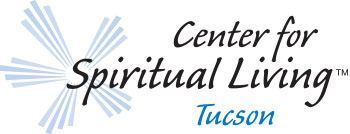In Gratitude…. by Rev. Rhoni Tretsven
 This past Sunday, the Center for Spiritual Living, Tucson held our annual meeting, where we elected and approved of new Board members. A rite of passage that happens every October. An important event in the life of our spiritual community. When I became the spiritual leader of CSLT, Mariann Moery, Chris Wheeler, Janet Salese and Linda Bullock were the standing Board members having already given 3 years of dedication. Sharon Whealy, RScP joined later in the year. As their new minister I asked, well, more like begged them to stay on for one more year since I was not familiar with the congregation to begin asking for “volunteers” to help me navigate the church. You see, the Board is responsible for the business/financials of the CSLT, and I am responsible for the ecclesiastical and education as a Science of Mind Center. We work as a team to create a safe, supportive, and spiritual environment for all of us.
This past Sunday, the Center for Spiritual Living, Tucson held our annual meeting, where we elected and approved of new Board members. A rite of passage that happens every October. An important event in the life of our spiritual community. When I became the spiritual leader of CSLT, Mariann Moery, Chris Wheeler, Janet Salese and Linda Bullock were the standing Board members having already given 3 years of dedication. Sharon Whealy, RScP joined later in the year. As their new minister I asked, well, more like begged them to stay on for one more year since I was not familiar with the congregation to begin asking for “volunteers” to help me navigate the church. You see, the Board is responsible for the business/financials of the CSLT, and I am responsible for the ecclesiastical and education as a Science of Mind Center. We work as a team to create a safe, supportive, and spiritual environment for all of us.
In the last two years there have been significant shifts in our congregation. Many beautiful souls that were here in my beginning, have made their transition, or have moved to be closer to family. I reflect often on the joy they shared, and grateful for their presence in the life of CSLT and the gift they gave me knowing them. At the beginning of this year, we moved from our Little Theatre Workshop location, to sharing sacred space with Unity of Tucson. This was to support our growing community. In the process we have made the decision to either rent or sell our previous office space on Craycroft. I am sure most of you had no idea some of the “magic” that happens behind the scenes! Nothing stays static, everything eventually shifts or completely changes. It keeps us all busy, in a good way.
My reason for sharing this with all of you, is Mariann, Chris, Janet, Linda, Sharon, and I have made some significant decisions. Each one being closely scrutinized for the health and prosperity of our beloved CSLT. It wasn’t always easy, but we worked together and got it done. The Board of Trustees is a very important element of our Center. It is because of these individuals who said “yes” for another year, we are, in my humble opinion, doing very well. On Sunday the 19th, I will be honoring Mariann and Chris for their dedication and service. They are the last of the original Board when I began this journey with all of you. If you see them on Sunday, please let them know your appreciation. It is beyond words the gratitude I have for their ”hanging in there” an additional year. I know they are tired, but somehow, they still manage to smile and show up to our meetings. They are beautiful, dedicated souls, thank you.
On Sunday the 19th, I will be “swearing in” and presenting our new Board members. Jeff Jackson, Sandy Schnieder, and Morgana Campbell. In addition, Rev. Donna Smith will be joining the Board in January. Sharon Whealy, RScP will continue as a Board member for the year 2026. As your spiritual director, I am very excited about these individuals. Each has a background in business, finance, teaching, organization or more. They are equally as excited and looking forward to digging deep into, what creates a cohesive community? As Jeff has expressed, we are looking for “sticky.” What is our “product” that people just “have to” have? There is more to it, however, but that is your invitation to being part of finding the “sticky.” Being part of the glue, creating a supportive, growing, fun, safe spiritual community. There is much ahead for all of us, and I am truly grateful for all that is, all that has been, and all that will continue to grow! Thank you all for being a significant change agent in the life of CSLT.
Namaste – Rev. Rhoni











